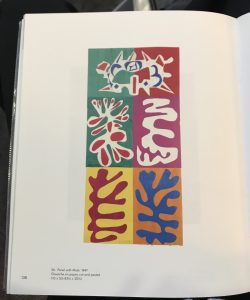(1) ‘Henri Matisse: The Cut-Outs’ by Karl Buchberg, Nicholas Cullinan and Jodi Hauptman’ , ’Panel with Mask’ 1947, Gouache on paper cut and pasted, 110 cm x 52 cm,
For my research task I have decided to look into the later work of Henri Matisse. During my visit to Winchester library I came across this image of Matisse’s work in the book ‘Henri Matisse: The Cut-Outs’ by Karl Buchberg, Nicholas Cullinan and Jodi Hauptman.
I was particularly drawn to the this image due to Matisse’s use of fluid, organic shapes and the contrast of this against his bold colour palette made up of complementary colours which really highlight the shapes he has made.
![]()
(2) Matisse’s studio, Hôtel Régina, Nice, c. 1953. (Photo: Lydia Delectorskaya. © 2014 Succession H. Matisse) from https://www.biography.com/news/henri-matisse-the-cut-outs-moma
After coming across my previous image (1) in the library, I turned to the internet for my research. I found out that during the last decade of Matisse’s life illness and old age meant that he was unable to draw and paint in the dynamic manner he used to and this resulted in him producing some of his most well known artworks (including … ) using the simplest of techniques which he described as ‘drawing with scissors’.
Matisse worked in his studio in Nice and following surgeries for severe intestinal disease he was restricted to mostly working in his wheelchair or bed. As a result of this confinement, working with paper was ideal. Studio assistants painted the sheets of paper with Gouache paint in the colours he chose and Matisse cut the shapes out of the paper using scissors- a technique he could make work from his wheelchair or bed. The shapes were then pinned to the walls of his studio and he adjusted the compositions for the final arrangement. For larger works Matisse’s assistants pinned large cut out shapes directly to the studio walls and he directed them to move the shapes into the compositions he desired.
From my internet research I was surprised by how large some of Matisse’s paper cuts were (as seen in the photograph above (2) – the scale of the pieces was something I was unable to see from the images in the book I looked at previously.

